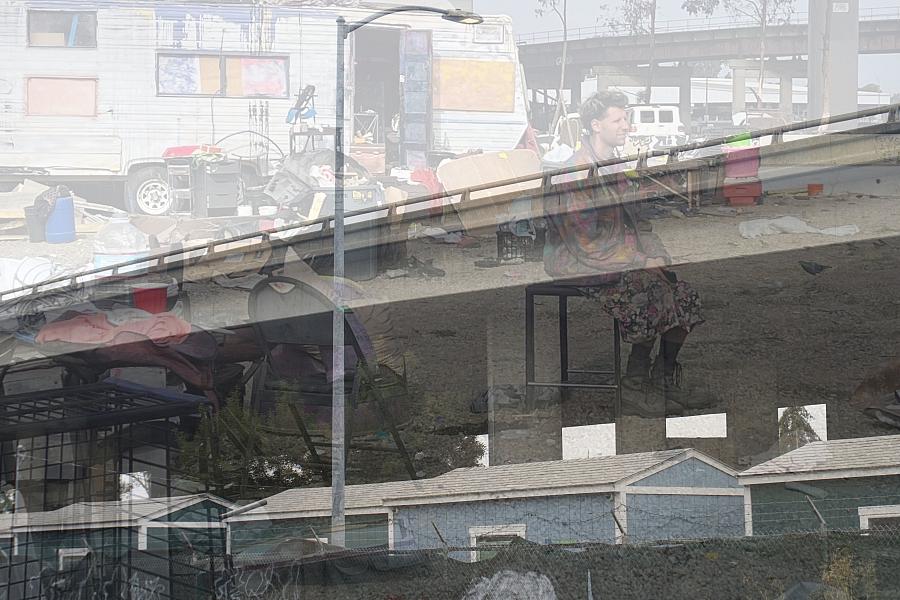Is ‘opportunity housing’ the answer to California’s lack of housing and shelter beds?

(Image via Ellie Prickett-Morgan)
“At least no one has died inside them yet.” That’s what Clutch, a resident of Oakland’s Wood Street Community Cabins, had to say about his new home. Clutch is a veteran, a mechanic, and a former resident of the Wood Street encampment.
This past spring his residence at the Wood Street encampment — at the time the largest unhoused encampment in Northern California — was cleared by the city of Oakland and Caltrans. In its place, albeit on a much smaller lot, is what the city of Oakland calls a community cabin site, which for at least the next six months Clutch will call home.
Community cabins or tiny homes are a model of housing that cities across California, including Oakland and San Francisco, have adopted as an intermediary step that allows unhoused individuals to get resources and access to a private tiny home in order to eventually land them in permanent housing.
Because of the low startup costs associated with building a community cabin site, they’re a popular choice. In March, California Gov. Gavin Newsom pledged $30 million to build 1,200 small homes across the state.
Despite their cost effectiveness, the cabins themselves are not universally loved by residents. The structures can lack heating and plumbing, and they typically sit on gated lots with no communal gathering space. The size of the cabins, often no bigger than 120 square feet, prevent residents from accumulating belongings. But for many these conditions are worth stomaching because if the program works, in six months they will leave for permanent housing.
Whether or not community cabins actually get people into permanent housing in Alameda and San Francisco counties is something I am interested in examining with data. But I am also interested in a new development in the community cabin approach to solving homelessness: opportunity housing.
The main difference between opportunity housing and existing community cabin programs is that the homes themselves are intended to be modular, freeing them up to be placed on unused lots that might only be available temporarily, and allowing local municipalities to evade zoning and permitting restrictions that would apply to permanent structures.
State Sen. Josh Becker is sponsoring a bill that he hopes will make it easier to employ opportunity housing statewide. Becker also hopes to build his opportunity housing units to a standard that will allow them to qualify for federal Section 8 vouchers, of which 45,000 are currently going unused every year.
I’ve requested records from Alameda County and San Francisco’s Homeless Management Information Systems to evaluate the successes and failures of the community cabin system so far, which I think will provide a useful backdrop to explain how opportunity housing emerged. Building upon this data, my reporting for the 2023 Data Fellowship will also highlight resident perspectives, because ultimately programs like opportunity housing represent realities they have to live with.
One particular concern regarding tiny homes that unhoused folks have repeated time and time again in my reporting is a fear that the offer of tiny homes could be used as a pretext to clear unhoused encampments.
The precedent set by Martin v. Boise in 2018 prevents California municipalities from clearing unhoused individuals camping on public property unless the government can provide alternative shelter — although currently San Francisco Mayor London Breed is hoping to change that.
For the time being, it’s far easier to provide an unhoused person with a tiny home than a shelter bed or access to permanent housing. To then build those tiny homes to a slightly better standard to allow them to qualify for Section 8 is efficient and solutions-oriented thinking on the part of a government agency. But it might not represent the needs and desires of the residents it will serve.
Given that Section 8 vouchers can work for regular housing units so long as a landlord accepts the voucher — and in California it is illegal for landlords to refuse vouchers — there’s an inherent problem with the opportunity housing proposal: If you could live in apartment with Section 8, why would you want to live in a tiny home that could be moved at any time?
Part of the problem here is that Section 8 discrimination is rampant in California, and the state has a severe lack of affordable housing units. My goal is to use this project to determine whether opportunity housing is a worthwhile program in its own right, or if it is merely a Band-Aid for the ongoing unhoused crisis.

